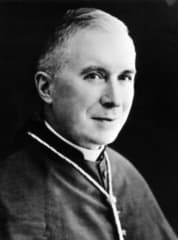アヴェ・マリア・インマクラータ!
愛する兄弟姉妹の皆様、
レネー神父様の霊的講話「無原罪の御宿りについて」(日本語訳)をご紹介いたします。
天主様の祝福が豊かにありますように!
トマス小野田圭志神父(聖ピオ十世会司祭)
天主の御摂理は、無原罪の御宿りの教義に対して全てを明らかにする光を当てるのを、十九世紀まで延期しました。その理由は、この教義が私たちの生きている現代世界にとってかつてないほど重要だったからです。現代人は、自分たちに天主は必要ないと思っており、すべてのことに対して人間の自然の理性で十分だと思っているのです。それに反して、無原罪の御宿りは、私たちが原罪を持って生まれ、いまだに罪の四つの傷を持っているということを私たちに思い起こさせます。そのため私たちには、私たちの主イエズス・キリストの恩寵が必要なのです。
聖母の無原罪の美しさを観想すると、私たちは自分の罪深さをより一層理解します。完全な白さのそばにいるとき、人は一層自分の闇を見るのです。しかし、この観想は私たちをがっかりさせるどころか、また私たちの主イエズス・キリストの恩寵の力を示し、それゆえに、天主が本当に私たちを罪から救い、私たちを聖化してくださるという確信で私たちの霊魂を上げるのです。それについて聖ペトロはこう言います。「私たちに尊い偉大な約束が与えられた。それは、欲情が世の中に生んだ腐敗からあなたたちを救い上げ、天主の本性にあずからせるためであった」(ペトロ後書1章4節)。
私たちが自分の人間としての条件を考察すればするほど、私たちはちっぽけな被造物にすぎないことが一層明らかになります。私たちが、重力の法則、物理の法則、原子の法則、命の法則をつくり出したのではありません。科学者たちはこれらの法則を発見しますが、彼らがそれらの法則をつくるのではありません。そして、誰もそれらの法則から逃れることはできません。私たちは光と温かさを太陽に依存しています。私たちは農業では雨に依存し、入手できる食べ物に依存し、非常に多くのことに依存しています。私たちは、この世にある何百万という銀河のうちの一つにある小さな太陽系の中の、小さな惑星に住む、ちっぽけな被造物でしかありません。ですから、私たちは詩篇作者とともに、感嘆の気持ちを抑えることができません。「あなたが御心にとめられるこの人間とは何者か。あなたが心を配られるこの人の子とは何者か」(詩篇8章5節)。でも、天主がすべてのことを知らなかったとしたら、この小さな惑星である地球上にいるこれらの人間というちっぽけな被造物を含め、ご自分のつくられたすべてのものを知らなかったとしたら、その天主はとうてい天主とは言えません。被造物として、私たちは私たちの創り主に依存しています。創り主はすべてのものに運動を与えて開始させただけでなく、また、すべてのものの存在を保っておられます。ですから創り主は第一動者であり、宇宙の共通善のために、天主の法によって被造物が適切な動きをするよう、被造物を導いておられるお方です。
私たちの被造物としての条件から、私たちが天主へ二重に依存していることが導かれます。私たちは、自分の存在を、自分の実在を天主に依存しています。私たちの中にある良いものはすべて天主からやって来るのであり、その第一原因として天主に依存しています。私たちはまた、自分の行動についても天主に依存しています。第一動者がいなければ、私たちは自分の小指一本さえ動かすことができなかったことでしょう。実際、天主が私たちに力強さや健康をお与えにならなかったなら、私たちは体が麻痺してしまうでしょう。時たま、天主がこの賜物を取り去られたときに、 私たちが病気になり、それまではできて当然と思っていたことが自分でできなくなったときにやっと、私たちはこの天主への依存に気付くのです。
「天主に依存していること」についての教会の教えを聞きたがらない人々がいます。彼らはそれが「人間の尊厳」を損なうと感じているのですが、そんな恐れは最も不合理であり、大変な傲慢を表しているだけです。実際、赤ん坊が母親に依存しているという事実が赤ん坊を傷つけるでしょうか? まったくそんなことはありません! 赤ん坊はむしろ母親の腕の中にいる方が、一人にされるよりもずっと幸せです! ですから、私たちも天主の腕の中にいるときの方がより偉大で、より良いものとなるのです。なぜでしょうか? まさに、天主はすべての善の源であるからです。私たちの中にあるすべての良いものは天主から来ます。天主は本当に私たちについて気にかけてくださっており、そのため私たちは、天主に依存して、天主の腕の中で、天主の御心に触れて、天主への依存のうちに生きることが私たちにとって良いことなのです。
しかし、その人々はこう言うでしょう。「私たちは自由だ! だから私たちは天主から自由であるべきだ! 人間の尊厳は、この自由にあるのだ!」。ここで私たちはまさに罪の核心に触れます。傲慢です。そのような傲慢は、まことの自由の間違った理解によって精神を盲目にしてしまいます。謙遜は真理と結びついています。つまり謙遜とは、真理によって、自分自身を正しい場所に置くことです。ですから、王の中の王である私たちの主イエズス・キリストは、こうおっしゃることがおできになりました。「私は柔和で謙遜な者であるから、くびきをとって私に従え。そうすれば霊魂は休む」(マテオ11章29-30節)。主はなぜ謙遜なのでしょうか? 主はまことの天主でありかつまことの人間でいらっしゃいます。主は人間として、ご自分の人間の本性が天主の本性に依存していることを、完全にお認めになりました。それをお認めになったことが、私たちの救いのために主がご自身を十字架上で犠牲にするよう命じられた御父の命令への従順へと結びついたのです(ヨハネ10章18節参照)。それは大変な命令でした! しかし、まさにこの従順によって、主は世の贖い主となられたのです!
まことの自由を理解するためには、物質的な全被造物、最も大きな銀河から最も小さな原子の中の素粒子に至るまで、天主がそれらに定められた命令、すなわち重力や電磁力などに完全に従っていることを考察するのは良いことです。全宇宙にある素粒子の中で、天主の法則に完全に従うことのないものは一つとしてありません。しかし、皆さんはこうおっしゃるかもしれません。それらの物質的被造物は自由ではなくて、必要に迫られて従っているのだ、と。実際そうです。でも、その従順がそれらの物質的被造物の美しさをつくり出します。夕日の美しさから、一輪の花の美しさや虹の美しさなどです。しかし、天主は霊魂を持つ被造物をつくられ、彼らに自由を授けられました。それは、彼らが必要に迫られてではなく、愛のために従うようにです。ですから、私たちが愛のために天主に従うとき、それは一層美しいものとなるのです。しかし、最も重要なのは、天主は、私たちが天主の法に不従順になるように私たちに自由をお与えになったのではなく、愛のために天主の法に従順になるように私たちに自由をお与えになったということを覚えておくことです。
罪はまさにこのように天主への服従を拒否することであり、天主の法への従順を拒否すること、私たちが被造物であるという真理を拒否することです。天主に対するこの反乱は、次のサタンの叫びに要約されています。「私はもうお仕えしない」(エレミア2章20節)。そしてこんにち、どれだけ多くの人々がこの反乱の叫びを繰り返していることでしょう! そんな反乱が、人類を苦しめるすべての苦難や悪の原因です。自己中心、暴力、盗み、殺人、あらゆる種類の不潔、そのあとに続いて起こる体の病気などです。
しかし、私たちが天主の法から逃れることができると考えるのは、ばかげたことです。実際、聖アウグスティノは言っています。「人は従順に生きることによって天主の法に基づいて報いを受けるか、もしくは、不従順に生きることによってやはり天主の法に基づいて罰を受けるかのどちらかしかない」。天主が悪に最終決定をさせることはあり得ません。天主は善そのものであり、罪によって台無しになった秩序を回復されるのです。こうして、すべての罪は天主の秩序のもとに、あわれみの秩序か正義の秩序のどちらかのもとに、服従せねばなりません。天主は私たちに選択権をお与えになっています。私たちがここ地上で、悔悛とまことの回心によって自分自身を罰し、次の世で天主に寛大に扱っていただくのか、あるいはここ地上で天主に戻ることを強情に拒否し、次の世で天主に罰せられるか、のいずれかです。ですから、天主に反乱を起こすことは全くばかげたことですが、それこそが傲慢によって引き起こされる盲目の状態なのです!
さて、無原罪の御宿りは傲慢の反対です。ご自分の受胎の始まり以来受けられた恩寵の充満によって、聖母は天主の法に完全に服従され、いとも完全な謙遜をもって、常にその法を実践するよう努められました。その謙遜が明らかになったのは天使へのお答えでした。「われは主のつかいめなり。仰せのごとくわれになれかし」(ルカ1章38節)。そしてこういうわけで、主が何度も何度も繰り返して「すべて自ら高ぶる者は下げられ、自らへりくだる者は上げられる」(マテオ23章12節、ルカ14章11節、18章14節)と言われたように、聖母は他の全てにまさって高く上げられたのです。
恩寵は罪のための薬であり、罪のための解毒剤です。進んで愛のために天主に自ら服従し、私たちが天主に依存していることを認め、天主と私たちの上下関係の真理を認めることと、恩寵とは常に結びついています。第一に、私たちの過去の罪という真理です。私たちは過去の罪を、天主の恩寵によって、心の底から嫌い、進んでその償いをするのです。天主へのこの服従が私たちを信仰へと導きます。なぜなら信仰は、知性を啓示された天主のみ言葉に服従させることだからです。天主への服従はまた、私たちを希望へと導きます。私たちは希望によって天主の御助けを信頼し、永遠の命へと至るために天主の道に素直に従うのです。そして最後に、天主への服従は私たちを愛徳へと導きます。私たちは愛徳によって自分の意志とすべての愛を天主に完全に服従させ、自分の心の中の最高の場所を天主に捧げるのです。つまり、この世的な考えに邪魔をさせたり、天主から私たちを離させたりしないのです。
そのように進んで天主に服従することが、自由を取り去ってしまうことは全くありません。その反対です。天主への服従は、私たちを罪から自由に、この世の魅惑や束縛への奴隷状態から自由に、悪から自由にするのです。そうして悪はもはや私たちの霊魂へ近づくことができなくなるのです。私たちの体が苦しみを受ける時にさえ、天主の恩寵はその苦しみを驚くべき報いとともに愛という素晴らしい宝石に変えるのです。聖パウロが「今の時の苦しみは、私たちにおいて現れるであろう光栄とは比較にならないと思う」(ローマ8章18節)と言うように。
私たちはそれを聖母に見るのです。聖母は恩寵の充満によって、完璧に天主に服従されました。それが聖母の自由を抑圧したのでは決してありません。聖母は常に、自ら進んで天主をお喜ばせすることをなさいました。天主への従順は自由に反しているのではありません。これは現代世界の大きな誤解の一つです。その反対に、従順を愛することは、まず、何が正しいかを判断する知性における光と、その正しいことをしたいという意志における愛を暗示しています。またその反対に、天主への不従順は、知性における光の拒否と、意志における悪意-傲慢-を暗示しています。天主への不従順によって、人は罪の奴隷となるのです。
天主は至高の存在であり、そのため天主の自由は至高であって何物にも従いません。私たちは被造物であり、それゆえ天主に従います。そのため、私たちの自由は被造物の自由であり、それゆえにこの自由は自分自身の規則ではなく、天主から最終的な規則を受けるのです。しかし、私たちにとっては天主に従順であることが良いことです! 私たちの従順が天主に益を与えるのではありません。天主はより良くなったりより幸せになったりすることはおできにならないからです。従順は、聖母において明らかなように、私たちや私たちの仲間の人間に益を与えるのです。聖母は、聖母ご自身のより大いなる幸せと私たちのより大きな益のために、究極的には天主の栄光のために、天と地の元后となられたのですから。その天主の栄光は、天主ご自身の善をさらに増すのではなく、被造物における天主の知恵の輝きなのです。その天主の栄光は 被造物に幸せを、永遠の幸せをもたらすのです! 無原罪の聖母は、天のすべての天使や聖人を超えて、自らに与えられた完徳という崇高な高みに上げられたことよって、恩寵の力をお示しになります。聖母は私たちのための恩寵の経路に、すべての恩寵の仲介者になられたのです。
恩寵の力はまた、天主が聖マリア・マグダレナのような重い罪を犯した罪びとたちをあわれんで偉大な聖人たちに変えられるときに、目に見えるものとなります。しかし、天主が童貞聖マリアのような無垢な霊魂たちを愛されようとも、マリア・マグダレナのような罪びとを愛されようとも、天主は常に彼らを聖人にしたいとお望みです! 天主はまさにあわれみ深いお方であるがゆえに、私たちが罪にとどまるのでなく、むしろもう罪に生きることのないよう罪から霊魂を癒やすことをお望みです。私たちの主イエズス・キリストが姦淫の罪を犯した女に言われたのは、このことです。「私もあなたを罰しない。行け、これからはもう二度と罪を犯さぬように」(ヨハネ8章11節)。イエズスはまた、ベトサイダの池で癒やした足なえにこう言われました。「どうだ、あなたは治った。さらに悪いことが起こらぬように、もう二度と罪を犯すな」(ヨハネ5章14節)。ルターやカスパー枢機卿のようなこんにちの近代主義者たちは、主のこの訓戒「二度と罪を犯すな!」を忘れています。その結果はこうです。罪人は罪にとどまり、そのため天国へ行くことはできません! ですから、ルターの「信仰のみによる救い」は、救いの全く反対です。カスパー枢機卿のあわれみは、天主のあわれみとは全く反対です。どちらも欺く者であり、罪びとをその罪にとどまらせ、それによって彼らを地獄へと導くのです。
聖母は無原罪であり、あわれみの御母です。聖母は天主から最も高い段階に至る御あわれみを、正確に言えばあらゆる罪を免れてより高い様式で贖われるという御あわれみを受けられました。聖母の無原罪の御宿りは、天主の御あわれみが決して人を罪にとどまらせることはないこと、天主の御あわれみが全く罪と反対であるために天主の傑作である聖母は完全に罪から免れているということを、はっきりと示しているのです! 聖母は御あわれみを受けられたので、今度は聖母が今、私たちに天主の御あわれみを分配なさっています。しかし、無原罪であるため、聖母は罪の泥の中に私たちを放っておかれはしません。聖母はむしろ、私たちを罪から離されます。泥の中に、罪のぬかるみの中にいる子どもを見て、いったいどんな母親がそこに子どもを放っておくでしょうか? 放っておくはずがありません! むしろ聖母は私たちを清め、「小羊の血で服[霊魂]を洗って白く」(黙示録7章14節)なさるでしょう。
さて、聖母を無原罪とし、数えきれないほどの罪びとを癒やし、聖化するすべての驚くべき恩寵、これらすべての恩寵は、私たちの主イエズス・キリストの十字架上の犠牲から来るのです。ここにこそ、天主の御あわれみが最も明確に示されています。天主の御子は私たちの罪による罰を自ら引き受けられ、私たちの負う負債を御父にお返しになり、私たちすべてのために聖化の恩寵を取り成してくださいました。私たちへの天主の愛は、これほどまでのものなのです! いまやその犠牲は私たちの祭壇で毎日捧げられており、そのため、ミサの聖なる犠牲が天主の御あわれみの経路なのです。そのミサにおいて、罪びとが悔い改めの恩寵を得るのです。十字架上での私たちの主の死ののち、聖ルカは「これを見に集まった人々も起こったことを見て、みな胸を打ちながら帰って行った」(ルカ23章48節)と記しています。彼らは胸を打ちながら、最高の犠牲にあずかったことで、彼らに天主の恩寵が触れたのです!
その犠牲において、ローマ典文が言うように、「清いいけにえ、聖なるいけにえ、汚れなきいえにえ」が捧げられました。汚れなきいけにえは、私たちの主イエズス・キリストの御体と御血です。そしてこのいけにえは、すべての汚れなき命の源なのです。このいけにえは霊魂を清め、無垢の状態を保ちます。汚れなき聖母は、ご托身の日に主を受けるにふさわしくあるために汚れなきお方でした。聖母はまた、汚れなきいけにえとして主と完全に一致するために汚れなきお方でした。こうして聖母は、ミサの聖なる犠牲と深く一致しておられるのです。
こうしてすべてのミサで毎回さらに深く小羊の血で清められて、私たちは天国の永遠の命に入る準備をしているのです。天国には「清くない者、いとわしい者、偽る者は誰もここに入れない。ただ小羊の命の書に書かれている者だけが入る」(黙示録21章27節)のですから。
無原罪の聖母が私たちみなのためにこの恩寵を取り成してくださいますように! アーメン。
愛する兄弟姉妹の皆様、
レネー神父様の霊的講話「無原罪の御宿りについて」(日本語訳)をご紹介いたします。
天主様の祝福が豊かにありますように!
トマス小野田圭志神父(聖ピオ十世会司祭)
2016年12月11日 待降節第3主日―大阪
霊的講話 「無原罪の御宿りについて」
霊的講話 「無原罪の御宿りについて」
天主の御摂理は、無原罪の御宿りの教義に対して全てを明らかにする光を当てるのを、十九世紀まで延期しました。その理由は、この教義が私たちの生きている現代世界にとってかつてないほど重要だったからです。現代人は、自分たちに天主は必要ないと思っており、すべてのことに対して人間の自然の理性で十分だと思っているのです。それに反して、無原罪の御宿りは、私たちが原罪を持って生まれ、いまだに罪の四つの傷を持っているということを私たちに思い起こさせます。そのため私たちには、私たちの主イエズス・キリストの恩寵が必要なのです。
聖母の無原罪の美しさを観想すると、私たちは自分の罪深さをより一層理解します。完全な白さのそばにいるとき、人は一層自分の闇を見るのです。しかし、この観想は私たちをがっかりさせるどころか、また私たちの主イエズス・キリストの恩寵の力を示し、それゆえに、天主が本当に私たちを罪から救い、私たちを聖化してくださるという確信で私たちの霊魂を上げるのです。それについて聖ペトロはこう言います。「私たちに尊い偉大な約束が与えられた。それは、欲情が世の中に生んだ腐敗からあなたたちを救い上げ、天主の本性にあずからせるためであった」(ペトロ後書1章4節)。
私たちが自分の人間としての条件を考察すればするほど、私たちはちっぽけな被造物にすぎないことが一層明らかになります。私たちが、重力の法則、物理の法則、原子の法則、命の法則をつくり出したのではありません。科学者たちはこれらの法則を発見しますが、彼らがそれらの法則をつくるのではありません。そして、誰もそれらの法則から逃れることはできません。私たちは光と温かさを太陽に依存しています。私たちは農業では雨に依存し、入手できる食べ物に依存し、非常に多くのことに依存しています。私たちは、この世にある何百万という銀河のうちの一つにある小さな太陽系の中の、小さな惑星に住む、ちっぽけな被造物でしかありません。ですから、私たちは詩篇作者とともに、感嘆の気持ちを抑えることができません。「あなたが御心にとめられるこの人間とは何者か。あなたが心を配られるこの人の子とは何者か」(詩篇8章5節)。でも、天主がすべてのことを知らなかったとしたら、この小さな惑星である地球上にいるこれらの人間というちっぽけな被造物を含め、ご自分のつくられたすべてのものを知らなかったとしたら、その天主はとうてい天主とは言えません。被造物として、私たちは私たちの創り主に依存しています。創り主はすべてのものに運動を与えて開始させただけでなく、また、すべてのものの存在を保っておられます。ですから創り主は第一動者であり、宇宙の共通善のために、天主の法によって被造物が適切な動きをするよう、被造物を導いておられるお方です。
私たちの被造物としての条件から、私たちが天主へ二重に依存していることが導かれます。私たちは、自分の存在を、自分の実在を天主に依存しています。私たちの中にある良いものはすべて天主からやって来るのであり、その第一原因として天主に依存しています。私たちはまた、自分の行動についても天主に依存しています。第一動者がいなければ、私たちは自分の小指一本さえ動かすことができなかったことでしょう。実際、天主が私たちに力強さや健康をお与えにならなかったなら、私たちは体が麻痺してしまうでしょう。時たま、天主がこの賜物を取り去られたときに、 私たちが病気になり、それまではできて当然と思っていたことが自分でできなくなったときにやっと、私たちはこの天主への依存に気付くのです。
「天主に依存していること」についての教会の教えを聞きたがらない人々がいます。彼らはそれが「人間の尊厳」を損なうと感じているのですが、そんな恐れは最も不合理であり、大変な傲慢を表しているだけです。実際、赤ん坊が母親に依存しているという事実が赤ん坊を傷つけるでしょうか? まったくそんなことはありません! 赤ん坊はむしろ母親の腕の中にいる方が、一人にされるよりもずっと幸せです! ですから、私たちも天主の腕の中にいるときの方がより偉大で、より良いものとなるのです。なぜでしょうか? まさに、天主はすべての善の源であるからです。私たちの中にあるすべての良いものは天主から来ます。天主は本当に私たちについて気にかけてくださっており、そのため私たちは、天主に依存して、天主の腕の中で、天主の御心に触れて、天主への依存のうちに生きることが私たちにとって良いことなのです。
しかし、その人々はこう言うでしょう。「私たちは自由だ! だから私たちは天主から自由であるべきだ! 人間の尊厳は、この自由にあるのだ!」。ここで私たちはまさに罪の核心に触れます。傲慢です。そのような傲慢は、まことの自由の間違った理解によって精神を盲目にしてしまいます。謙遜は真理と結びついています。つまり謙遜とは、真理によって、自分自身を正しい場所に置くことです。ですから、王の中の王である私たちの主イエズス・キリストは、こうおっしゃることがおできになりました。「私は柔和で謙遜な者であるから、くびきをとって私に従え。そうすれば霊魂は休む」(マテオ11章29-30節)。主はなぜ謙遜なのでしょうか? 主はまことの天主でありかつまことの人間でいらっしゃいます。主は人間として、ご自分の人間の本性が天主の本性に依存していることを、完全にお認めになりました。それをお認めになったことが、私たちの救いのために主がご自身を十字架上で犠牲にするよう命じられた御父の命令への従順へと結びついたのです(ヨハネ10章18節参照)。それは大変な命令でした! しかし、まさにこの従順によって、主は世の贖い主となられたのです!
まことの自由を理解するためには、物質的な全被造物、最も大きな銀河から最も小さな原子の中の素粒子に至るまで、天主がそれらに定められた命令、すなわち重力や電磁力などに完全に従っていることを考察するのは良いことです。全宇宙にある素粒子の中で、天主の法則に完全に従うことのないものは一つとしてありません。しかし、皆さんはこうおっしゃるかもしれません。それらの物質的被造物は自由ではなくて、必要に迫られて従っているのだ、と。実際そうです。でも、その従順がそれらの物質的被造物の美しさをつくり出します。夕日の美しさから、一輪の花の美しさや虹の美しさなどです。しかし、天主は霊魂を持つ被造物をつくられ、彼らに自由を授けられました。それは、彼らが必要に迫られてではなく、愛のために従うようにです。ですから、私たちが愛のために天主に従うとき、それは一層美しいものとなるのです。しかし、最も重要なのは、天主は、私たちが天主の法に不従順になるように私たちに自由をお与えになったのではなく、愛のために天主の法に従順になるように私たちに自由をお与えになったということを覚えておくことです。
罪はまさにこのように天主への服従を拒否することであり、天主の法への従順を拒否すること、私たちが被造物であるという真理を拒否することです。天主に対するこの反乱は、次のサタンの叫びに要約されています。「私はもうお仕えしない」(エレミア2章20節)。そしてこんにち、どれだけ多くの人々がこの反乱の叫びを繰り返していることでしょう! そんな反乱が、人類を苦しめるすべての苦難や悪の原因です。自己中心、暴力、盗み、殺人、あらゆる種類の不潔、そのあとに続いて起こる体の病気などです。
しかし、私たちが天主の法から逃れることができると考えるのは、ばかげたことです。実際、聖アウグスティノは言っています。「人は従順に生きることによって天主の法に基づいて報いを受けるか、もしくは、不従順に生きることによってやはり天主の法に基づいて罰を受けるかのどちらかしかない」。天主が悪に最終決定をさせることはあり得ません。天主は善そのものであり、罪によって台無しになった秩序を回復されるのです。こうして、すべての罪は天主の秩序のもとに、あわれみの秩序か正義の秩序のどちらかのもとに、服従せねばなりません。天主は私たちに選択権をお与えになっています。私たちがここ地上で、悔悛とまことの回心によって自分自身を罰し、次の世で天主に寛大に扱っていただくのか、あるいはここ地上で天主に戻ることを強情に拒否し、次の世で天主に罰せられるか、のいずれかです。ですから、天主に反乱を起こすことは全くばかげたことですが、それこそが傲慢によって引き起こされる盲目の状態なのです!
さて、無原罪の御宿りは傲慢の反対です。ご自分の受胎の始まり以来受けられた恩寵の充満によって、聖母は天主の法に完全に服従され、いとも完全な謙遜をもって、常にその法を実践するよう努められました。その謙遜が明らかになったのは天使へのお答えでした。「われは主のつかいめなり。仰せのごとくわれになれかし」(ルカ1章38節)。そしてこういうわけで、主が何度も何度も繰り返して「すべて自ら高ぶる者は下げられ、自らへりくだる者は上げられる」(マテオ23章12節、ルカ14章11節、18章14節)と言われたように、聖母は他の全てにまさって高く上げられたのです。
恩寵は罪のための薬であり、罪のための解毒剤です。進んで愛のために天主に自ら服従し、私たちが天主に依存していることを認め、天主と私たちの上下関係の真理を認めることと、恩寵とは常に結びついています。第一に、私たちの過去の罪という真理です。私たちは過去の罪を、天主の恩寵によって、心の底から嫌い、進んでその償いをするのです。天主へのこの服従が私たちを信仰へと導きます。なぜなら信仰は、知性を啓示された天主のみ言葉に服従させることだからです。天主への服従はまた、私たちを希望へと導きます。私たちは希望によって天主の御助けを信頼し、永遠の命へと至るために天主の道に素直に従うのです。そして最後に、天主への服従は私たちを愛徳へと導きます。私たちは愛徳によって自分の意志とすべての愛を天主に完全に服従させ、自分の心の中の最高の場所を天主に捧げるのです。つまり、この世的な考えに邪魔をさせたり、天主から私たちを離させたりしないのです。
そのように進んで天主に服従することが、自由を取り去ってしまうことは全くありません。その反対です。天主への服従は、私たちを罪から自由に、この世の魅惑や束縛への奴隷状態から自由に、悪から自由にするのです。そうして悪はもはや私たちの霊魂へ近づくことができなくなるのです。私たちの体が苦しみを受ける時にさえ、天主の恩寵はその苦しみを驚くべき報いとともに愛という素晴らしい宝石に変えるのです。聖パウロが「今の時の苦しみは、私たちにおいて現れるであろう光栄とは比較にならないと思う」(ローマ8章18節)と言うように。
私たちはそれを聖母に見るのです。聖母は恩寵の充満によって、完璧に天主に服従されました。それが聖母の自由を抑圧したのでは決してありません。聖母は常に、自ら進んで天主をお喜ばせすることをなさいました。天主への従順は自由に反しているのではありません。これは現代世界の大きな誤解の一つです。その反対に、従順を愛することは、まず、何が正しいかを判断する知性における光と、その正しいことをしたいという意志における愛を暗示しています。またその反対に、天主への不従順は、知性における光の拒否と、意志における悪意-傲慢-を暗示しています。天主への不従順によって、人は罪の奴隷となるのです。
天主は至高の存在であり、そのため天主の自由は至高であって何物にも従いません。私たちは被造物であり、それゆえ天主に従います。そのため、私たちの自由は被造物の自由であり、それゆえにこの自由は自分自身の規則ではなく、天主から最終的な規則を受けるのです。しかし、私たちにとっては天主に従順であることが良いことです! 私たちの従順が天主に益を与えるのではありません。天主はより良くなったりより幸せになったりすることはおできにならないからです。従順は、聖母において明らかなように、私たちや私たちの仲間の人間に益を与えるのです。聖母は、聖母ご自身のより大いなる幸せと私たちのより大きな益のために、究極的には天主の栄光のために、天と地の元后となられたのですから。その天主の栄光は、天主ご自身の善をさらに増すのではなく、被造物における天主の知恵の輝きなのです。その天主の栄光は 被造物に幸せを、永遠の幸せをもたらすのです! 無原罪の聖母は、天のすべての天使や聖人を超えて、自らに与えられた完徳という崇高な高みに上げられたことよって、恩寵の力をお示しになります。聖母は私たちのための恩寵の経路に、すべての恩寵の仲介者になられたのです。
恩寵の力はまた、天主が聖マリア・マグダレナのような重い罪を犯した罪びとたちをあわれんで偉大な聖人たちに変えられるときに、目に見えるものとなります。しかし、天主が童貞聖マリアのような無垢な霊魂たちを愛されようとも、マリア・マグダレナのような罪びとを愛されようとも、天主は常に彼らを聖人にしたいとお望みです! 天主はまさにあわれみ深いお方であるがゆえに、私たちが罪にとどまるのでなく、むしろもう罪に生きることのないよう罪から霊魂を癒やすことをお望みです。私たちの主イエズス・キリストが姦淫の罪を犯した女に言われたのは、このことです。「私もあなたを罰しない。行け、これからはもう二度と罪を犯さぬように」(ヨハネ8章11節)。イエズスはまた、ベトサイダの池で癒やした足なえにこう言われました。「どうだ、あなたは治った。さらに悪いことが起こらぬように、もう二度と罪を犯すな」(ヨハネ5章14節)。ルターやカスパー枢機卿のようなこんにちの近代主義者たちは、主のこの訓戒「二度と罪を犯すな!」を忘れています。その結果はこうです。罪人は罪にとどまり、そのため天国へ行くことはできません! ですから、ルターの「信仰のみによる救い」は、救いの全く反対です。カスパー枢機卿のあわれみは、天主のあわれみとは全く反対です。どちらも欺く者であり、罪びとをその罪にとどまらせ、それによって彼らを地獄へと導くのです。
聖母は無原罪であり、あわれみの御母です。聖母は天主から最も高い段階に至る御あわれみを、正確に言えばあらゆる罪を免れてより高い様式で贖われるという御あわれみを受けられました。聖母の無原罪の御宿りは、天主の御あわれみが決して人を罪にとどまらせることはないこと、天主の御あわれみが全く罪と反対であるために天主の傑作である聖母は完全に罪から免れているということを、はっきりと示しているのです! 聖母は御あわれみを受けられたので、今度は聖母が今、私たちに天主の御あわれみを分配なさっています。しかし、無原罪であるため、聖母は罪の泥の中に私たちを放っておかれはしません。聖母はむしろ、私たちを罪から離されます。泥の中に、罪のぬかるみの中にいる子どもを見て、いったいどんな母親がそこに子どもを放っておくでしょうか? 放っておくはずがありません! むしろ聖母は私たちを清め、「小羊の血で服[霊魂]を洗って白く」(黙示録7章14節)なさるでしょう。
さて、聖母を無原罪とし、数えきれないほどの罪びとを癒やし、聖化するすべての驚くべき恩寵、これらすべての恩寵は、私たちの主イエズス・キリストの十字架上の犠牲から来るのです。ここにこそ、天主の御あわれみが最も明確に示されています。天主の御子は私たちの罪による罰を自ら引き受けられ、私たちの負う負債を御父にお返しになり、私たちすべてのために聖化の恩寵を取り成してくださいました。私たちへの天主の愛は、これほどまでのものなのです! いまやその犠牲は私たちの祭壇で毎日捧げられており、そのため、ミサの聖なる犠牲が天主の御あわれみの経路なのです。そのミサにおいて、罪びとが悔い改めの恩寵を得るのです。十字架上での私たちの主の死ののち、聖ルカは「これを見に集まった人々も起こったことを見て、みな胸を打ちながら帰って行った」(ルカ23章48節)と記しています。彼らは胸を打ちながら、最高の犠牲にあずかったことで、彼らに天主の恩寵が触れたのです!
その犠牲において、ローマ典文が言うように、「清いいけにえ、聖なるいけにえ、汚れなきいえにえ」が捧げられました。汚れなきいけにえは、私たちの主イエズス・キリストの御体と御血です。そしてこのいけにえは、すべての汚れなき命の源なのです。このいけにえは霊魂を清め、無垢の状態を保ちます。汚れなき聖母は、ご托身の日に主を受けるにふさわしくあるために汚れなきお方でした。聖母はまた、汚れなきいけにえとして主と完全に一致するために汚れなきお方でした。こうして聖母は、ミサの聖なる犠牲と深く一致しておられるのです。
こうしてすべてのミサで毎回さらに深く小羊の血で清められて、私たちは天国の永遠の命に入る準備をしているのです。天国には「清くない者、いとわしい者、偽る者は誰もここに入れない。ただ小羊の命の書に書かれている者だけが入る」(黙示録21章27節)のですから。
無原罪の聖母が私たちみなのためにこの恩寵を取り成してくださいますように! アーメン。










